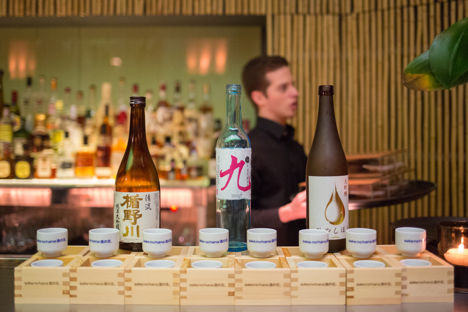
Sake and salmon: a pairing masterclass
We enlisted the help of Sake no Hana head chef Hideki Hiwatashi and Oliver Hilton-Johnson from Tengu Sake to find out how these two ingredients go hand in hand.
Sake and salmon: a pairing masterclass
We enlisted the help of Sake no Hana head chef Hideki Hiwatashi and Oliver Hilton-Johnson from Tengu Sake to find out how these two ingredients go hand in hand.
It’s a little known fact that it was Norway that introduced raw salmon to the Japanese as late as the 1970s, and ever since the two nations have had a very close culinary relationship. Practically every piece of salmon eaten in Japan is imported from Norway, and it has completely changed the cuisine of the country in as little as fifty years. It’s just a very happy coincidence that the savoury, acidic and fruity flavours of sake – Japan’s national drink – marry perfectly with the fatty richness of the fish.
Sake no Hana is one of the best Japanese restaurants in the UK, and head chef Hideki Hiwatashi has been working with salmon his entire career, even spending time with the fishermen to understand how they are caught. If anyone was able to showcase the versatility of Norwegian salmon in Japanese cooking, it was him – which is why we invited selected journalists and bloggers to a masterclass hosted by Hideki and Oliver Hilton-Johnson, a sake expert and founder of Tengu Sake.
The first sake we had was Tatenokawa 50 ‘Stream’, made in the junmai daiginjo style (where the rice is polished down to around fifty percent of its original size and no extra alcohol is added) specifically for people who like white wine. The perfect sake for beginners, it had plenty of fresh, fruity notes of melon and pears, with a refreshing crisp finish. Served with a salmon and avocado maki and a torched piece of salmon (aburi) with yuba (the skin formed when making tofu), it cut through the rich, fresh flavour of the raw fish beautifully.
Next up was Gozenshu 9 ‘Mountain Stream’, the most interesting of the lot. Unpasteurised and with a distinctly umami flavour that made the mouth water, it was much more savoury than the others on offer whilst retaining a fruitiness that made it all the more intriguing. This sake was served with a classic salmon nigiri, which came with a little dot of Japanese mustard on top, as well as a very interesting cooked parcel of salmon wrapped in a leaf, complete with edible ‘twigs’ made from deep-fried soba noodles.
Finally, the Konishi Gold was truly special – a sake that’s been years in the making and is created in very cold temperatures with as little exposure to the air as possible to prevent oxidisation. This gave it a light, elegant clarity with very obvious flavours of pear and citrus that arguably helped create the best pairing of the night; a thin piece of salmon (usuzukuri) served in a truffle and ponzu sauce.


